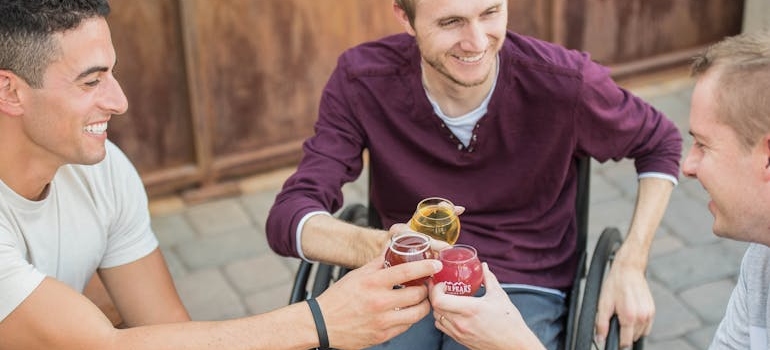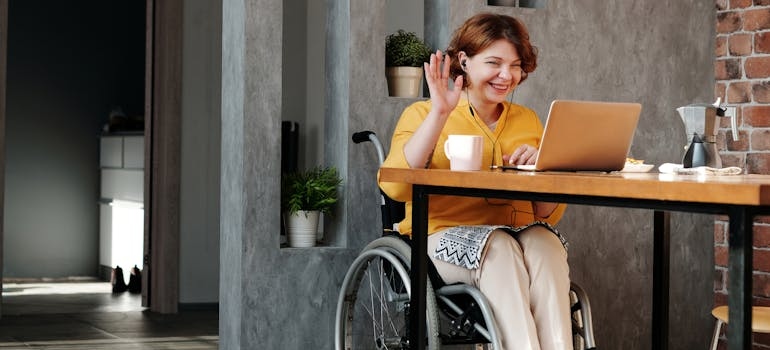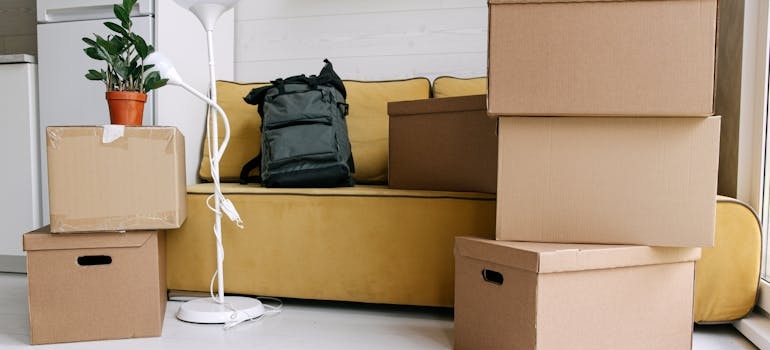Moving Tips for People With Disabilities
For many, the word “moving” triggers thoughts of chaos and clutter. But for people with disabilities, it’s more than just a logistical puzzle—it’s a test of resilience and creativity. What if you could turn this challenge into an opportunity for empowerment? Imagine moving into a space that’s not just a house but a true haven for your needs. So let our Idaho movers transform the often-overwhelming task of moving into a step-by-step journey, with moving tips for people with disabilities designed to help you thrive in your new environment.
Why Your Moving Strategy Matters More Than You Think
Moving with a disability demands a plan that goes beyond the standard checklist. It’s not just about packing boxes; it’s about ensuring your independence and comfort at every stage. Start by creating a personalized timeline that includes everything from scouting for accessible housing to arranging for medical and mobility equipment transport.
Focus on setting achievable goals within a practical timeframe. Identify tasks that could be delegated to others, whether hiring a professional moving services Boise ID offers or calling in favors from friends and family. Breaking the process into smaller, manageable steps reduces stress and gives you a sense of control over your move.

Packing Techniques for Special Equipment
Mobility aids, assistive devices, and other specialized equipment are more than just belongings—they’re essential to your daily life. Properly packing these items ensures that they reach your new home in perfect condition. Disassemble larger devices if possible, and pack each part with bubble wrap or foam padding to prevent damage.
Label each box clearly and include setup instructions for reassembly. This approach will help you or your moving team quickly and correctly set up essential equipment in your new space. It’s also wise to keep the most critical items, like medications or medical devices, in a travel bag that stays with you during the move.
Finding the Right Moving Team That Understands Your Needs
The difference between a smooth move and a stressful one often comes down to choosing the right moving company. When dealing with disabilities, you need movers who understand your requirements and have the tools and training to meet them. Start by searching for companies specializing in accessible relocations or those with experience in medical equipment shipping services and handling this sensitive equipment.
Ask these critical questions before hiring:
- Do you provide adaptive vehicles for wheelchair users?
- Can your team handle delicate medical devices with care?
- What measures do you take to ensure accessibility at every stage of the move?
Gathering feedback from others in your community or seeking recommendations from disability support organizations can also guide you toward trustworthy movers who will treat your possessions with the care they deserve.
Emotional and Psychological Aspects of Moving
Moving isn’t just a physical challenge—it’s an emotional one as well. Leaving behind familiar surroundings can be tough, especially if you’ve built a support system in your current community. Make sure to have open conversations with your friends and family about your needs, and involve them in the move as much as possible.
Engaging with online communities or local support groups can make your transition easier by connecting you with others who share similar experiences. Learning from their moving tips for people with disabilities provides invaluable emotional support, helping transform your move from a daunting ordeal into an empowering experience. Finding people who understand your journey offers both encouragement and practical advice to navigate this significant change with confidence.
Leveraging Technology to Simplify Your Move
Technology can transform the process of moving with a disability into a more organized and manageable experience. Apps like Trello and Google Keep help streamline tasks, set reminders, and track your progress, giving you a clear picture of what needs to be done.
GPS-based Tools
GPS-based tools are also essential when adjusting to your new neighborhood. They help you find the most accessible routes and locate nearby services like grocery stores, pharmacies, and public transport that cater to your needs. Before moving, consider taking virtual home tours to evaluate the property’s accessibility features. This approach allows you to identify potential issues or necessary modifications before committing to a location, saving you both time and effort.

Adaptive Technologies for Easier Moves
Using technology to your advantage can simplify many aspects of moving. For persons with disabilities, adaptive technologies are invaluable tools that enhance independence and streamline daily tasks. Voice-activated systems like Amazon Alexa or Google Home can help control smart home devices hands-free. Those systems manage everything from lighting and temperature to alarms and reminders, reducing physical strain and keeping you organized during the move.
Specialized Apps
Several specialized apps are designed to ease the moving experience, especially for those seeking tailored moving tips for people with disabilities. These digital tools offer practical assistance and ensure that you stay organized and on track during your relocation:
- Moving Planner Apps: Platforms like Sortly allow you to inventory items, label boxes, and track your possessions during the move, keeping everything well-organized.
- Accessibility Apps: Tools like Be My Eyes or Seeing AI provide real-time assistance for persons with visual impairments, using smartphone cameras to navigate and recognize objects.
- Health and Safety Apps: Staying on top of your medications and medical appointments is made simpler with apps like Medisafe, ensuring that your health remains a priority amid the chaos of relocation.
These digital tools don’t just help you stay organized; they also act as a support system, allowing you to focus on the move itself without getting overwhelmed by details. Leveraging these technologies means more time for what matters—settling into your new home with confidence and ease.
Financial Support and Resources
Navigating the financial aspects of moving can be tricky, especially if you need to make modifications to your new home for accessibility. Look into state and federal programs that offer grants or low-interest loans for home improvements aimed at increasing accessibility for people with disabilities.
Nonprofit organizations like Rebuilding Together and the National Council on Independent Living (NCIL) may also offer financial assistance for specific accessibility upgrades. Exploring these options early in the planning process can alleviate some of the financial burden and allow you to focus on settling into your new environment.
Financial Aid and Grants for Accessibility Upgrades
Accessibility modifications can be costly, but several funding options are available to help offset these expenses. Research grant programs are offered by state or federal governments and non-profit organizations dedicated to assisting persons with disabilities. The U.S. Department of Housing and Urban Development (HUD) and organizations like the National Association of Home Builders (NAHB) offer resources that may fund modifications to make your home more accessible.
Legal Rights and Housing Accessibility
Understanding your legal rights regarding accessible housing can be crucial when choosing a new place. The Fair Housing Act in the U.S. prohibits discrimination against persons with disabilities, requiring property owners to make reasonable accommodations or allow modifications to enhance accessibility. Know your rights when negotiating lease agreements or asking for changes to your living space.
Requesting Housing Modifications
If you need to make adjustments to a rental property to meet your mobility or sensory needs, it’s essential to know how to approach your landlord. Examples of reasonable modifications include:
- Installing grab bars in the bathroom
- Lowering countertops for wheelchair access
- Adding a ramp or stair lift
Open communication with your landlord, along with understanding your rights, can make the process smoother. If necessary, seek support from local disability advocacy organizations that can guide you through legal processes.

Practical Tips for Long-Distance Moves
Long-distance moves add another layer of complexity, but they’re entirely manageable with the right approach and the long distance movers Boise recommends. Focus on planning for every stage, including the journey itself. If you’re traveling by car or public transport, plan accessible routes and accommodations ahead of time to avoid complications. Make sure all mobility equipment is well-protected during transport to prevent damage.
Medical Preparations for the Journey
Traveling with disabilities often involves careful planning around medical needs. Pack a travel kit that includes all essential medications, medical documents, and emergency contact information. Ensure that your medical equipment is fully charged or has backup power sources, especially for battery-operated devices like oxygen concentrators or power wheelchairs.
Adjusting to New Surroundings
Adapting to a new environment can be a gradual process, especially when accessibility is a primary concern. Explore your neighborhood to find essential services like grocery stores, medical facilities, and accessible public transport options. Many cities have specific resources or centers dedicated to helping persons with disabilities, which can make your adjustment period smoother.
Involving Family and Friends in the Moving Process
The support of family and friends can make the moving experience far less daunting. Involve them in the process by assigning specific tasks according to their strengths. Whether organizing your belongings, packing up your home, or helping with the unpacking, a coordinated effort can lighten your load. If in-person assistance isn’t possible, virtual support through video calls can also provide guidance and moral support during this transition.
Building a Support Network in Your New Community
Relocating to a new area can be a chance to expand your support network and form connections that enrich your daily life. Engaging with local disability advocacy groups, recreational activities, or social clubs can help you integrate smoothly into your new surroundings. This sense of belonging provides a support system and a foundation for building meaningful relationships in your community.
Finding Local Support and Resources
Once you settle into your new neighborhood after moving to Idaho, proactively seek out local disability services and support groups. These organizations can introduce you to others who share similar experiences and can guide you to resources specifically tailored to your needs. Building a network of understanding acquaintances eases the transition and helps establish a sense of comfort and acceptance in your new home.
Don’t hesitate to connect with your neighbors. Open conversations about your needs and share relevant moving tips for people with disabilities to make it easier for others to offer their support. Establishing these relationships early can make your move into the community smoother and more enjoyable.
Community Involvement and Advocacy
Your move also provides a unique opportunity to engage in local disability advocacy efforts. Consider joining or supporting organizations that promote accessibility and inclusivity. Your involvement can be a powerful way to make a positive impact, improve your experience, and pave the way for future residents with disabilities.
Advocacy work enhances community resources, creating a more welcoming environment for everyone. These efforts help transform your new surroundings into a space where your voice is heard, and your needs are recognized, making your relocation more than just a move. It becomes a chance to contribute to a more inclusive community.

Customizing Your New Space for Accessibility
Before you even step through the door of your new home, think about how to make the environment work for you. Accessibility is about much more than just ramps and wide doorways. Consider installing smart home devices that can make everyday tasks easier.
Focus on adapting high-traffic areas first, like the kitchen and bathroom, to suit your needs. Ensure countertops are at a reachable height, switches, and outlets are easily accessible, and there’s plenty of open space for movement. The goal is to make the best of furniture installation services and make your new home functional, comfortable, and tailored precisely to your unique requirements.
Personalizing for Comfort and Independence
The ultimate goal of any move is to create a living space that supports your independence and makes you feel at home. Small adaptations like rearranging furniture for better mobility, installing lever-style door handles, or using contrasting colors for better visual clarity can significantly impact your daily life. Your home should be where you feel comfortable, empowered, and in control.
Creating Routines that Enhance Accessibility
Once you’ve settled, focus on building routines that make your new home as efficient as possible. Set specific spots for keys, mobility aids, or frequently used objects. Establishing consistent routines helps create a sense of normalcy and reduces the physical and mental effort of adjusting to new surroundings.
Celebrate Small Victories During Your Relocation
Every successful move is worth celebrating, especially when you’ve tackled the challenges of relocating with specific needs. Applying effective moving tips for people with disabilities can make the transition smoother and more empowering. Acknowledge the patience and resilience it takes to adjust to your new surroundings. Consider hosting a small gathering in your new space or treating yourself to something special to mark this milestone, celebrating the journey and the progress you’ve made toward building a home that supports your independence.

